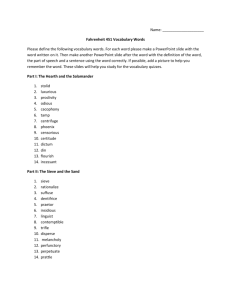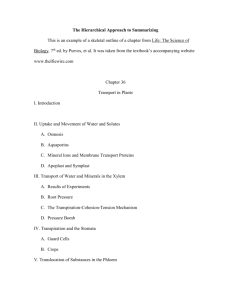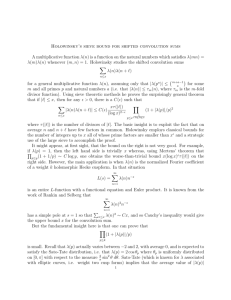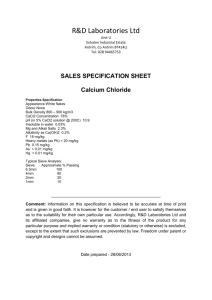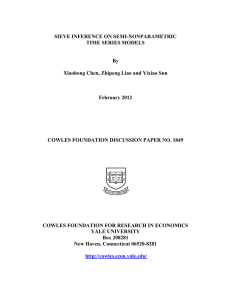LOWER BOUNDS FOR EXPRESSIONS OF LARGE SIEVE TYPE Jan-Christoph Schlage-Puchta
advertisement
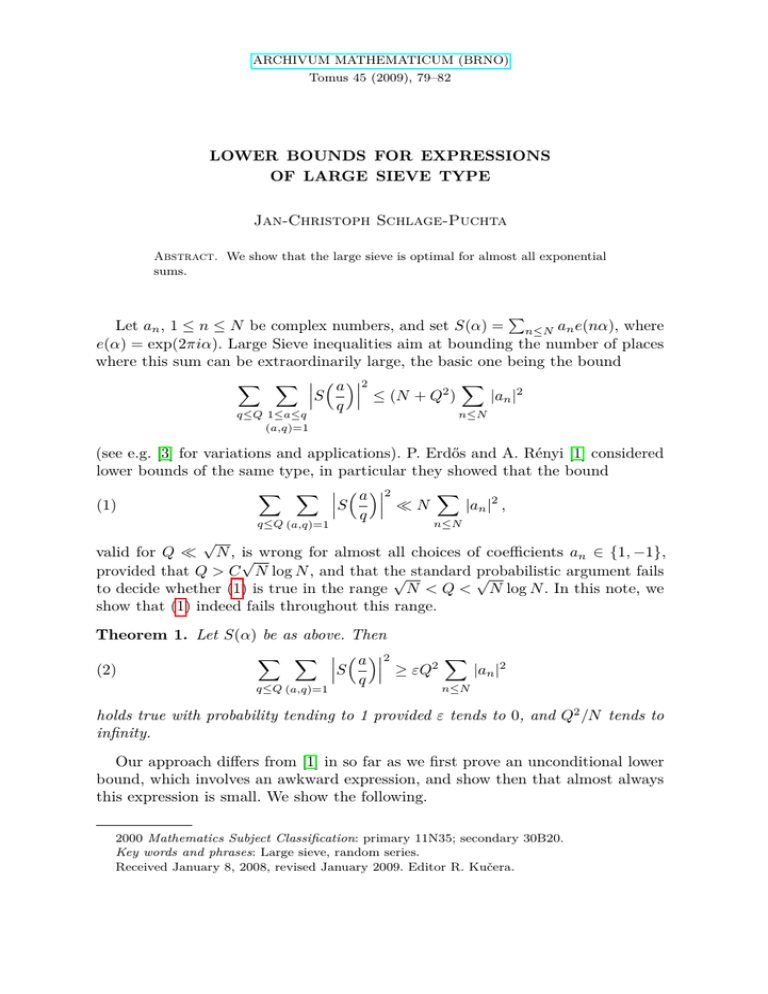
ARCHIVUM MATHEMATICUM (BRNO)
Tomus 45 (2009), 79–82
LOWER BOUNDS FOR EXPRESSIONS
OF LARGE SIEVE TYPE
Jan-Christoph Schlage-Puchta
Abstract. We show that the large sieve is optimal for almost all exponential
sums.
P
Let an , 1 ≤ n ≤ N be complex numbers, and set S(α) = n≤N an e(nα), where
e(α) = exp(2πiα). Large Sieve inequalities aim at bounding the number of places
where this sum can be extraordinarily large, the basic one being the bound
X X a 2
X
|an |2
S
≤ (N + Q2 )
q
q≤Q 1≤a≤q
(a,q)=1
n≤N
(see e.g. [3] for variations and applications). P. Erdős and A. Rényi [1] considered
lower bounds of the same type, in particular they showed that the bound
X X a 2
X
(1)
|an |2 ,
S
N
q
q≤Q (a,q)=1
n≤N
√
valid for Q N , √
is wrong for almost all choices of coefficients an ∈ {1, −1},
provided that Q > C N log N , and that the
probabilistic argument fails
√ standard √
to decide whether (1) is true in the range N < Q < N log N . In this note, we
show that (1) indeed fails throughout this range.
Theorem 1. Let S(α) be as above. Then
X X a 2
X
(2)
|an |2
S
≥ εQ2
q
q≤Q (a,q)=1
n≤N
holds true with probability tending to 1 provided ε tends to 0, and Q2 /N tends to
infinity.
Our approach differs from [1] in so far as we first prove an unconditional lower
bound, which involves an awkward expression, and show then that almost always
this expression is small. We show the following.
2000 Mathematics Subject Classification: primary 11N35; secondary 30B20.
Key words and phrases: Large sieve, random series.
Received January 8, 2008, revised January 2009. Editor R. Kučera.
80
J.-C. SCHLAGE-PUCHTA
Lemma 1. Let S(α) be as above, and define
R
M (x) = sup
m
m
R1
|S(u)|2 du
,
|S(u)|2
du
0
where m ranges over all measurable subsets of [0, 1] of measure x. Then for any
real parameter A > 1 we have the estimate
1 X
X X a 2 Q2 |an |2 .
1−M
− 6πN A
≥
S
q
A
A
(3)
n≤N
q≤Q (a,q)=1
Proof. Our proof adapts Gallagher’s proof of an upper bound large sieve [2]. For
every f ∈ C 1 ([0, 1]), we have
Z1
f (1/2) =
Z1/2
Z1
f (u) du +
uf 0 (u) du − (1 − u)f 0 (u) du .
0
0
1/2
Putting f (u) = |S(u)|2 , and using the linear substitution u 7→ (α − δ/2) + δu, we
obtain for every δ > 0 and any α ∈ [0, 1]
1
|S(α)| =
δ
2
α+δ/2
Z
1
|S(u)| du +
δ
2
α−δ/2
−
1
δ
Zα
δ/2 − |u − α| S 0 (u)S(−u) − S(u)S 0 (−u) du
α−δ/2
α+δ/2
Z
δ/2 − |u − α| S 0 (u)S(−u) − S(u)S 0 (−u) du .
α
We have |S(u)| = |S(−u)| and |S 0 (−u)| = |S 0 (u)|, thus |S 0 (u)S(−u)−S(u)S 0 (−u)| ≤
2|S(u)S 0 (u)|, and we obtain
1
|S(α)| ≥
δ
2
α+δ/2
Z
1
|S(u)| du −
δ
2
α−δ/2
1
≥
δ
α+δ/2
Z
2
2
−
|u − α| |S(u)S 0 (u)| du
δ
α−δ/2
α+δ/2
Z
2
α+δ/2
Z
|S(u)S 0 (u)| du .
|S(u)| du −
α−δ/2
1
α−δ/2
LOWER BOUNDS FOR THE LARGE SIEVE
81
We now set δ = A/Q2 . We can safely assume that δ < 12 , since our claim would be
trivial otherwise. Summing over all fractions α = aq with q ≤ Q, (a, q) = 1, we get
(4)
X
Z1
X a 2
Q2
|S(u)|2 du
≥
S
q
A
q≤Q (a,q)=1
0
Q2
−
A
Z
Z1
2
|S(u)| du −
R(u)|S(u)S 0 (u)| du ,
0
m(Q,A)
where
n
a Ao
R(u) = # a, q : (a, q) = 1, q ≤ Q, u − ≤ 2 ,
q
Q
and
m(Q, A) = u ∈ [0, 1] : R(u) = 0 .
To bound R(u), let aq11 < aq22 < · · · < aqkk be the list of all fractions with qi ≤ Q,
u − ai ≤ A2 . We have for i 6= j the bound
qi
Q
a
1
aj 1
i
≥ 2,
− ≥
qi
qj
qi qj
Q
that is, the fractions aq11 , . . . , aqkk form a set of points with distance > Q12 in an
2A
interval of length Q
2 . There can be at most 2A + 1 such points, hence, R(u) ≤ 3A.
Next, we bound |m(Q, A)|. By Dirichlet’s theorem, we have that for each real
1
number α ∈ [0, 1] there exists some q ≤ Q and some a, such that |α − aq | ≤ qQ
. If
A
1
α ∈ m(Q, A), we must have qQ > Q2 , that is, q < Q/A. Hence, we obtain
[
[ ha
1 a
1 i ha
A a
A i
|m(Q, A)| ≤ −
, +
− 2, + 2 \
q
qQ q
qQ
q
Q q
Q
q<Q/A (a,q)=1
Z Q/A
X ϕ(q)(2Q − 2Aq)
1
1
≤
≤ 2
2Q − 2At dt = .
2
qQ
Q 0
A
q<Q/A
We can now estimate the right hand side of (4). The first summand is
while the second is by definition at most
Cauchy-Schwarz-inequality to obtain
Z1
2
Q
A
Q2
A
2 Z1
Z1
2
|S(u)S (u)| du ≤
|S(u)| du
|S 0 (u)|2 du
0
=
X
0
X
|a2n |
n≤N
≤ (2πN )2
n≤N
|an |2 ,
M (1/A). For the third we apply the
0
0
P
(2πn)2 |a2n |
n≤N
X
n≤N
|a2n |
2
.
82
J.-C. SCHLAGE-PUCHTA
P
Hence, the last term in (4) is bounded above by 3A(2πN ) n≤N |an |2 , and inserting
our bounds into (4) yields the claim of our lemma.
Now we deduce Theorem 1. Let S(α) be a random sum in the sense that the
coefficients an ∈ {1, −1} are chosen at random. We compute the expectation of the
fourth moment of S(α).
Z1
E
|S(u)|4 du = E
X
aν1 aν2 aµ1 aµ2
µ1 +µ2 =ν1 +ν2
µ1 ,µ2 ,ν1 ,ν2 ≤N
0
= # µ1 , µ2 , ν1 , ν2 ≤ N : {µ1 , µ2 } = {ν1 , ν2 }
= 2N 2 − N.
1/2
R
√ R
If m ⊆ [0, 1] is of measure x, then |S(u)|2 du ≤ x
|S(u)|4 du
, thus
m
m
√
√
EM (x) ≤ 2x. In particular, we have M (x) ≤ 1/2 with probability ≥ 1 − 8x.
Let δ > 0 be given, and set A = 8δ −2 . Then with probability ≥ 1 − δ we have
M (1/A) ≤ 1/2, and (3) becomes
X
X X a 2 Q2 δ 2
−2
S
≥
−
48δ
πN
|an |2
q 16
n≤N
q≤Q (a,q)=1
2 2
≥
Q δ X
|an |2 ,
32
n≤N
2
4
provided that Q > √
1536δ N . Hence, for fixed , the relation (2) becomes true
with probability 1 − 1024, provided that Q2 /N is sufficiently large. Hence, our
claim follows.
I would like to thank the referee for improving the quality of this paper.
References
[1] Erdős, P., Rényi, A., Some remarks on the large sieve of Yu. V. Linnik, Ann. Univ. Sci.
Budapest. Eötvös Sect. Math. 11 (1968), 3–13.
[2] Gallagher, P. X., The large sieve, Mathematika 14 (1967), 14–20.
[3] Montgomery, H. L., Multiplicative Number Theory, Lecture Notes in Math. 227 (1971).
Department of Pure Mathematics and Computer Algebra
Universiteit Gent
Krijgslaan 281, 9000 Gent, Belgium
E-mail: jcsp@cage.ugent.be
